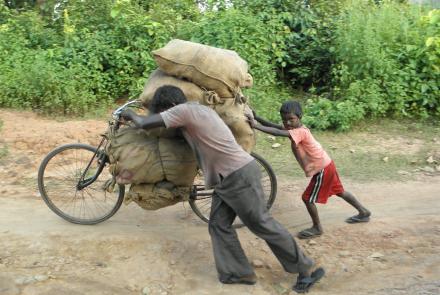
Photo by Kuntala Lahiri-Dutt.
Black dust and bicycles
Rural peasants once reliant on farming and forestry for their livelihood are turning to bicycles and India’s massive coal industry to survive, reports Kuntala Lahiri-Dutt.
Coal in India is much more than a mineral resource.
For a country where coal-fired thermal power plants produce most electricity and one where 540 million people are still waiting to be connected to the grid, coal has always been ‘a national asset’, a symbolic icon of national pride.
India is the world’s third-largest producer of coal, the only country that can boast a separate ministry for coal, and a place where the train to the collieries is lovingly named as the ‘Black Diamond Express’.
No other country has an equivalent to India’s Coal Bearing Areas Act (1951), which takes precedence over everything else, including all other legislation meant to protect the interests of the poor and the weak. Even private companies can use the law to acquire land for coal mining, pushing aside the poor as waste, the social overburden that has no value.
India’s coal mining industry takes the form of a large state-controlled juggernaut represented mainly by the public sector company, Coal India Limited (CIL). The company produces most of the country’s coal, and is one of the largest coal-producing companies globally. CIL is also one of the biggest employers, reflecting the labour-intensive nature of the industry. The Government of India has been trying to slowly ‘liberalise’ and ‘deregulate’ the Indian coal industry.
But in addition to the mega-corporations and the state, there is another coal economy in India. It is piled upon and carried over the humble bicycle and pushed by the local people. In spite of all the international awareness India’s coal industry generates, this is the least talked about one. And while the state and privately-owned companies feed the power plants, cities and large industries, this third coal economy contributes heavily to sustaining the local livelihoods of countless people throughout India’s coal-bearing tracts.
However, like most things in life, there is a price to pay; and it is the poor that pay the highest cost.
As the forest-clad hills are stripped off their cover by large open cut coal mines, the water table goes down and the local poor find that there is little or nothing in their surrounding environment to live on. Many of these villagers have traditionally been farmers, undertaking a monsoon-fed agriculture during the rainy season, and turning to the forests for gathering and collection of fruits, roots and other things, as well as for hunting small games, during the drier seasons.
The collection from forests has been replaced by ‘coal collection; instead of the cow that was once the traditional beast of burden, bicycles and their riders have become the new ‘workhorses’ of India’s countryside. Many locals now prefer to own a cycle on which they can pile up the coal. Sometimes, a cycle can carry even up to 350 kilograms of coal, although on an average, the weight would be about 250 kilograms.
The villagers gather this coal from either one of the large open-cut mines as scavengers or thieves, or by digging up their land that no longer produces enough rice that can fill up their bellies and sustain their families. A family of four usually cuts and sorts the coal themselves, sometimes working from 6am until 6pm in the evening. They take turns in pushing and pulling the cycles, particularly when climbing the undulating terrain. Earnings they get from this backbreaking work are meager, but may enable some families to send at least one child to school.
According to the mineral laws of India, coal is a ‘major’ mineral, meaning that only large companies can mine it. These thousands of people are technically involved in an illegal activity that is punishable by law. Popular media reports are usually against such mining and distribution of coal, often describing them as encroaching on environmental commons to hurt others’ well-being.
But most of those who push the heavy, coal-laden cycles consider it as their moral right to claim a bit of the resource that lay under the land that at one time belonged to them.
Associate Professor Kuntala Lahiri-Dutt is a senior fellow based at Crawford School.
She is also the Chief Investigator of an Australian Research Council Discovery Project, ‘Beyond the Resource Curse’, and is currently in India studying local coal cyclists.
For a thorough investigation of India’s coal mining, watch out for Kuntala Lahiri-Dutt’s edited book, The Coal Nation: Histories, Ecologies and Politics of Coal in India (Aldershot: Ashgate) forthcoming in January, 2014.
This article originally appeared on the ANU College of Asia and the Pacific website.
Updated: 27 July 2024/Responsible Officer: Crawford Engagement/Page Contact: CAP Web Team













